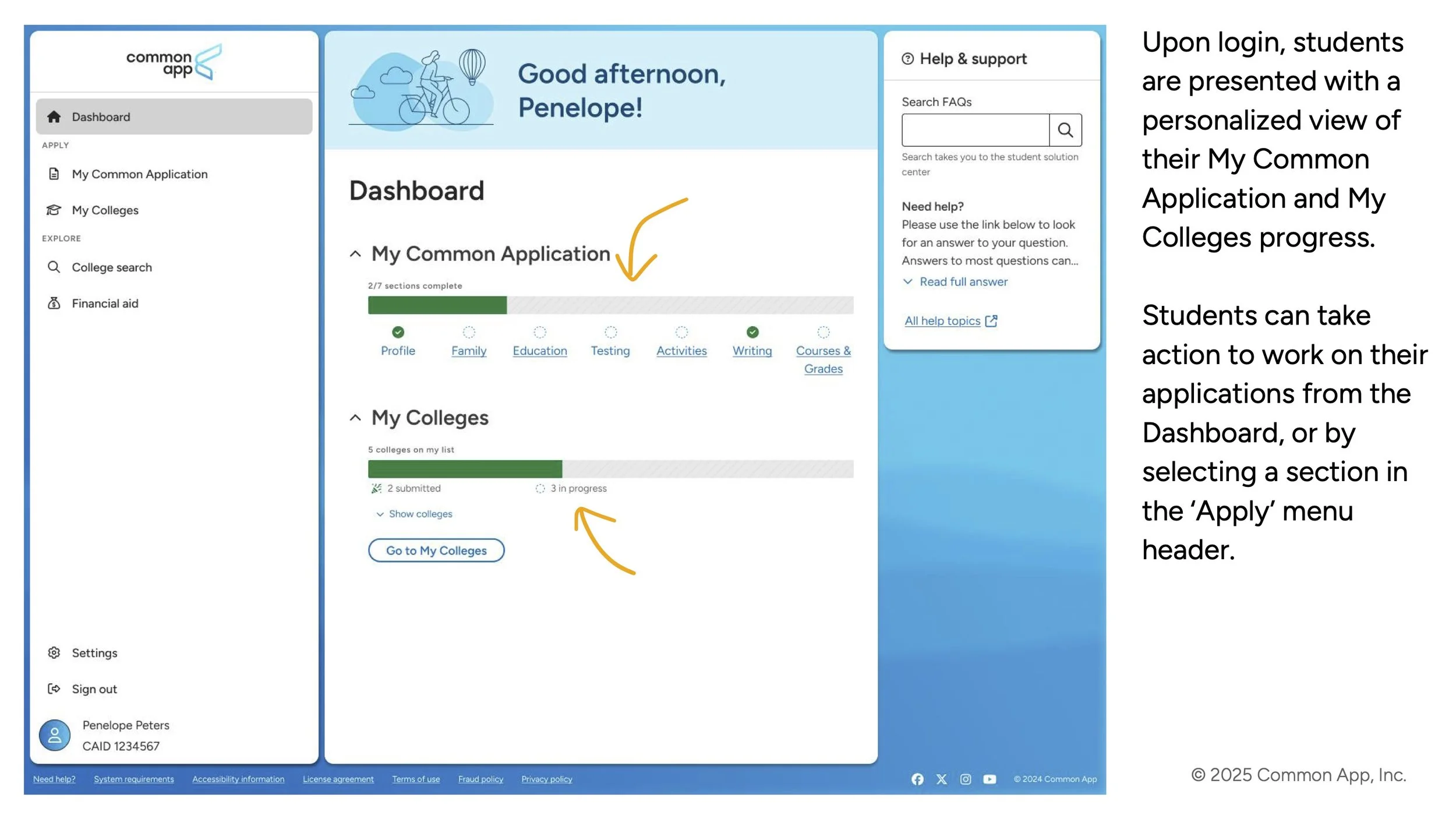The Common App—which allows you to apply to hundreds of college with just one application—will be going through some important changes once it re-launches on August 1. This post exists to ensure you’ve got the most up-to-date, cutting-edge info available!
“Cutting-edge college process info” is my middle name. (I’m aware it’s a long middle name, ok?!) For the past fifteen years now, I’ve helped hundreds of high schoolers land spots at the most competitive universities in the world….by dramatically raising their SAT and ACT test scores, and by helping them write compelling and authentic college application essays.
So trust me when I say I stay on top of recent changes to the Common App. And today I’m laying out each and every one of those evolutions for you.
If this is the first time you’re hearing about the Common App, you might want to also check out my Common App resource library. I’ve written tons of posts about this crucial element of the college process, and chances are, if you’ve got a question, I’ve answered it in the past!
ARTICLE CONTENTS
1. Watch this article as a video
2. Common App basics: what’s not changing
b. Basic content of the Common App website
b. The “Additional Information” question
c. New Layout of the Common App Website
4. Conclusion
Video version of this article:
Basics of the Common App
First things first: let's talk about the two major elements of the Common App that are remaining the SAME this year.
Common Application essay prompts
The first thing that is not changing this round is the core set of personal statement prompts.
As you may know, there are always seven essay questions that an applicant can use as the jumping-off point for their main Common Application essay (aka “Personal Statement”).
(Granted, it’s not easy to put your most compelling, yet most authentic, self on the page in just 650 words or less! That’s why I’ve dedicated so many posts and videos to helping you pull off that magic trick.)
Those seven essay prompts have been the same now for almost five years, and here they are, straight from the horse’s mouth.
Basic contents of the Common App website
The other aspect of the Common Application that will be remaining consistent from previous years is the overall workflow and functionality of the Common App website itself.
When you log in to the site, the information it’ll ask you to fill in—from the recommender system to your transcript—all stays the same.
What's different this year on the Common App?
Overall, there are three important changes that will set in this August 1, 2025 when the Common App reopens.
New version of the COVID essay prompt
The first big change is that the old “community disruption” essay prompt (also known as the COVID-19 question) is going to look different in the next version of the Common App.
As you may know, when we were all in the thick of COVID lockdown in August 2020, many high schoolers were deeply, materially affected by the pandemic. This, in turn, impacted their test scores, their grades, their mental health, and/or their physical health.
In response to those hardships, the Common App powers-that-be added an optional question in 2020:
Community disruptions such as COVID-19 and natural disasters can have deep and long-lasting impacts. If you need it, this space is yours to describe those impacts. Colleges care about the effects on your health and well-being, safety, family circumstances, future plans, and education, including access to reliable technology and quiet study spaces. For more information, check out our COVID-19 FAQ.
This was a 250-word essay that you could fill out IF you wanted to.
But beginning this August 1st, 2025, it's now going to be called the “Challenges and Circumstances” question. And this is the new language of the prompt:
Sometimes a student's application and achievements may be impacted by challenges or other circumstances. This could involve:
Access to a safe and quiet study space
Access to reliable technology and internet
Community disruption (violence, protest, teacher strikes, etc.)
Discrimination
Family disruptions (divorce, incarceration, job loss, health, loss of a family member, addiction, etc.)
Family or other obligations (caretaking, financial support, etc.)
Housing instability, displacement or homelessness
Military deployment or activation
Natural disasters
Physical health and mental well-being
War, conflict, or other hardships
If you're comfortable sharing, this information can help colleges better understand the context of your application. Colleges may use this information to provide you and your fellow students with support and resources.
Would you like to share any details about challenges or other circumstances you've experienced?
As that last sentence implies, this question is still optional. And the word limit (250) will remain the same.
Changes to the "Additional Information" question
The second of the three big shifts has to do with the “Additional Information” essay.
The question itself is not changing, and it will remain optional for applicants to respond to it. However, the word count will be shorter than it’s been in past years.
If you are a first-year applicant, then the limit is going to be reduced from 650 words to only 300 words maximum.
If you're a transfer student, then your limit will be reduced from 3,500 characters to 1,500 characters maximum.
New layout of the Common App website
The third major shift that the Common Application will be undergoing for the 2025-2026 application year is that the look and feel of the Common App is going to be very different when they relaunch it in August.
The online Common App portal will now look a little different. As I mentioned above, the functionality of the Common App interface—what info it’s actually asking for, and how you input it—will largely remain the same. But a few user experience elements will be tweaked:
A) First of all, the landing page will contain progress bars for the two projects you can complete on the site—“My Common Application” and “My Colleges.” Little green checkmarks will indicate which parts of the app you’ve filled out so far, such as “Profile,” “Family,” “Education,” etc.
B) “My Common Application” is a new term, too: it used to just be called “Common App,” but they’ll be changing that nomenclature. This helps clarify that we’re not talking about the Common App website (where you can go to find out basic info about the Common App) but about your individual application and how much you’ve filled out within it: your transcript, your activities, your personal statement, your test scores, etc.
C) “My Common Application” will also be the first tab on the navigation panel, whereas it used to be the second tab, after “My Colleges.”
D) In the navigation panel, the “Explore” heading will now be more prominent, streamlined, and helpful. One of the subheadings here is the college search, and the other one is financial aid. The former is where you're going to search for different colleges of interest to add to your “My Colleges” list. The “financial aid” section will help you find scholarships, grants, work-study, and other forms of money to help pay for your higher education.
Conclusion
So there you have it: the three changes coming down the pike for the Common App, and the two things that are staying the same.
Even though this post has clarified this aspect of the Common App, you might find yourself with more questions as you get started on your application. Fortunately, I offer one-on-one services that can give you a huge leg up:
The Ace the Common App Personal Statement package: I help you generate your main essay from A to Z. We’ll have you reflect upon meaty questions designed to bring out your most passionate stories and qualities; figure out your “organizing principle”; and help you craft a highly compelling, honest, and authentic-to-you personal statement that weaves together all the disparate parts of your transcript and activities list.
I also offer six-hour supplemental essay packages for all of those school-specific essay prompts (“Why Harvard?” “Write a letter to your future roommate,” etc.).
A budget-friendly option is my Ace the Personal Statement PDF, which breaks down all of my favorite do's and don'ts of the personal statement. There are some pretty common, pretty disastrous mistakes students make as they approach this tricky essay. Don’t let that be you.







